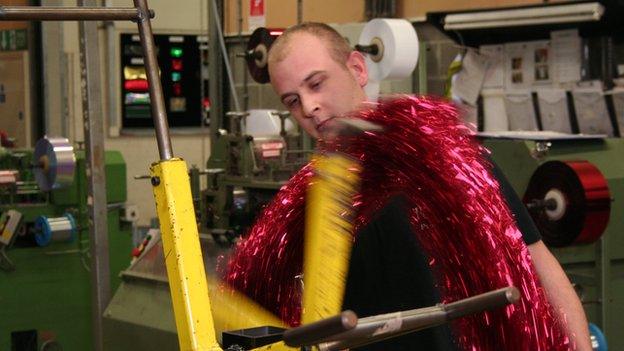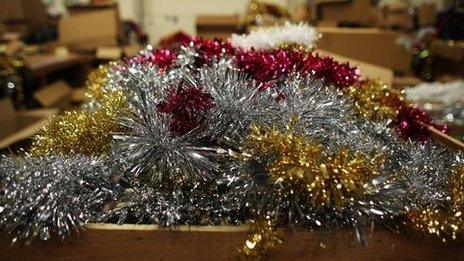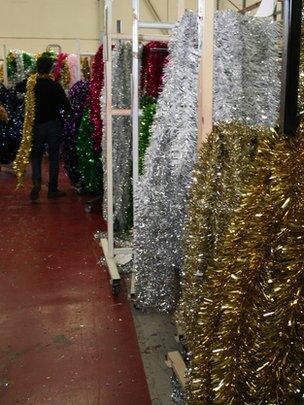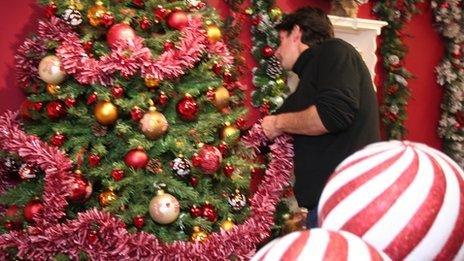Welsh 'Tinseltown' raises Christmas mystery
- Published

The company can produce 150,000m of tinsel per day when at full output
Cwmbran in south Wales seems an unlikely contender as Britain's capital of kitsch.
Yet the area, which is better known for the coal trade, is home to the country's only manufacturer of tinsel, which makes it the nation's real "Tinseltown".
It is here at Festive Productions where they make the stuff that many in the UK use to decorate trees and their homes at Christmas.
And it is no cottage industry. The company is one of the biggest tinsel producers in the world.
Festive Productions can turn out 150,000m of the sparkly stuff a day when it needs to.
And its market share would put a twinkle in the eye of any businessman or woman.
Reliable statistics on the country's tinsel consumption are hard to come by - after all, who is counting? - but the company reckons it makes almost two-thirds of all the tinsel sold in the UK.
That is enough, it says, to wrap the whole world in a glittery garland.
Bad traveller
So how has this Welsh company managed to hold out against the competition from China?

Festive Productions make about two-thirds of the UK's tinsel
After all, virtually everything else that sparkles, glimmers, glints or shines at Christmas comes from vast Chinese factories that work year round turning out forests of fake trees, seas of shimmering baubles, galaxies of Christmas lights and armies of ho-ho-ho-ing Santas.
The answer, says the company's chief executive Ian Newton, lies in the product itself.
"The fact is," he says, "tinsel doesn't travel well."
If you pack tinsel into a container and ship it halfway around the world, it comes out limp and flaccid, he explains.
What customers want, he says as he lifts up a thick golden rope of the stuff, is pert, bushy tinsel.
So even though labour costs are higher in south Wales than they are in the industrial parks of Southern China, it is still worth making tinsel in the UK.
"The proof of the business model is our customers," Mr Newton says.
"We sell to all the major supermarkets and to garden centres across the country. They just wouldn't buy from us if they could get good tinsel cheaper somewhere else."
'Multicoloured bling'
Rack after rack of shimmering cords of tinsel fill the insides of a fairly typical, large industrial unit, where Jason Poulsom, who has worked here for a quarter of a century, is eager to show off a wide array of products.
There are the usual reds, golds and silvers, as well as an incredible range of other colours. Gingham tinsel anyone?

A rainbow of colours for any festive fashion
There is a blend of cerise and burnt sienna with just a dash of an iridescent material, black with a glitzy purple, and off-even green with folded red strips to produce an impressive holly effect.
These concoctions are created in what looks like great big candy floss machines that shred the shiny plastic tape into strips, which in turn are drawn into a spinning bowl along with nylon string.
The spinning action binds the whole thing together into the familiar shiny rope.
Each machine can produce 25m of multicoloured bling every six minutes, Mr Poulsom says.
It is an impressive operation and clearly a big business, though in the greater scheme of things it is a relatively new one.
Festive Productions has only been around for 30 years.
German import?
So where does the UK's tinsel tradition come from?
That is something no-one seems to know the answer to.

The exact origin of the tinsel tradition is a mystery
Most Christmas customs have been pored over by the experts - Santa Claus, the Christmas tree, the giving of presents.
But it seems there is a tinsel-sized hole in the history of Christmas.
Historians agree that the origins of tinsel lie in 17th Century Germany.
That was when thin strips of gold and silver begun to be hung in trees to reflect the light of candles at Christmas time.
What no-one can say is when and how the tradition made its way to the UK.
There were strong links between Germany and Britain at the time, says Jenny Uglow of Queen Mary College, University of London.
So it is fair to assume that the UK would have followed the German fashion, she says, as it did in many other things.
Ms Uglow has written about how the UK imported the German tradition of garden gnomes in the 17th Century, for example.
But, as she acknowledges, there is no proof that tinsel made the same journey.
Modern Christmas
The Victorians are famous for their Christmas celebrations, yet David Oakley, curator of the Queen Victoria's Christmas exhibition at Windsor Castle, says there was no trace of tinsel on Queen Victoria's tree.

Decking the tree with tinsel is part of the Christmas traditions for many families
Daru Rooke, an expert on the Victorian home, says he has been through hundreds of Victorian Christmas cards dating all the way back to the 1860s, many of which depict trees.
None, he says, had tinsel.
That has led some scholars to insist that tinsel is a modern tradition in the UK.
Some believe that it was imported as recently as the 1930s, and not from Germany but from America, where it was then known as "icicles".
But wherever it comes from, the fact is that tinsel has become a byword for our modern Christmas.
- Published18 December 2012